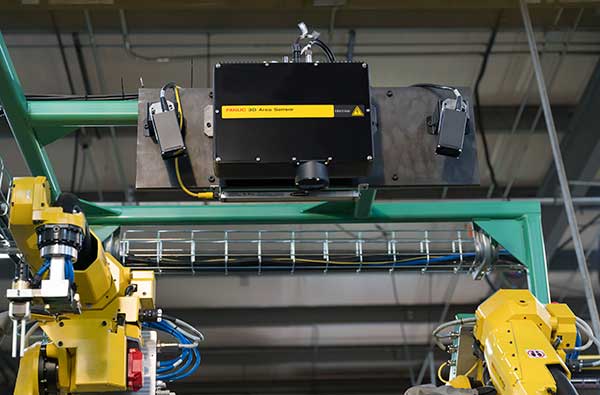
Machine vision is especially useful for identifying and tracking parts with complex shapes and inspecting parts before fixturing them throughout the manufacturing process.
In automated processes, 2D and 3D machine vision can cut waste and improve overall efficiency.
Machine vision has become an integral component of automated manufacturing processes. In older automated lines, less efficient methods were used to corral a product part down a conveyor and into a precise position for fixation. This more manual process often required additional hardware to direct parts in the proper direction or would require pre-fixturing a part with manual labor. This was time-intensive and made manufacturing processes susceptible to alignment errors.
Machine vision uses cameras to locate product parts throughout the entire manufacturing process. Once the camera has identified a part, it sends the part’s positioning information to the machine. This enables the machine to pick the part up and secure it for the next step in the manufacturing process.
Machine vision is especially useful for identifying and tracking parts with complex shapes. The technology is also used in tandem with barcode, QR code, and other traceability methods. It is also useful for inspecting parts before fixturing them throughout the manufacturing process—limiting the number of faulty parts making their way into the final product.
Machine vision systems employ either 2D or 3D cameras to conduct live-time iteration, part inspection, and increase efficiency. Both offer unique benefits, based on the application.
2D machine vision is less expensive more efficient than 3D systems and often used in combination with backlighting to enable quick and easy part identification.
Benefits
On the whole, machine vision is much more efficient than manual sorting and fixturing. Machine vision is also more accurate, giving the larger machine a better sense of part alignment and type. The technology also provides more flexibility in the manufacturing process. It mitigates the need for new hardware or the development of new manual processes any time manufacturers want to use an existing machine process for a new product. This greatly reduces the initial startup costs and time when testing something new, thereby limiting the risk that’s often associated with new-product development.
Machine vision also offers a lot more consistency than manual processes. The visual information cameras can pick up is highly detailed—enabling machine-vision systems to conduct in-depth part inspections and defect detection. This decreases the amount of waste and defects throughout manufacturing, saving time and critical resources while minimizing the potential for customer returns down the line.
3D vision is helpful with especially complex shapes, particularly because it can capture Z coordinate data that 2D cameras cannot.
2D vs. 3D
Machine vision setups offer more consistency and efficiency than automated processes that don’t utilize machine vision. While newer 3D cameras are increasing in prevalence, 2D cameras are still preferable in some cases.
2D machine vision is less expensive and more efficient. 2D is often used in combination with backlighting to enable quick and easy part identification. Because the 2D images are less complex than 3D, 2D systems are much faster than their 3D counterparts. This increases the overall throughput of the manufacturing process. Additionally, by using 2D cameras at various points in the manufacturing process, multiple 2D pictures can be integrated in a way that resembles 3D camera output. Overall, 2D is an ideal fit for identifying and locating parts with a simple shape.
2D machine vision is also perfect for barcode reading throughout manufacturing processes. Using barcodes and QR codes on individual product components has effectively transformed traceability metrics throughout supply chains. Now, companies can use machine vision to track, trace, and report key supply chain metrics to stakeholders.
Where 3D vision can be helpful is with especially complex shapes. In the past decade, camera costs have dropped significantly, allowing automated manufacturing processes to use higher quality and therefore more accurate cameras. 3D vision systems are no exception. High-quality 3D cameras can capture helpful Z coordinate data that 2D cameras cannot.
Most Wauseon Machine automated systems are currently equipped with machine vision in some capacity. We have also developed innovative solutions to process issues such as light exposure from outside sources during manufacturing. By incorporating infrared light in machine-vision camera systems, the captured light is put out of the spectrum of visible light. This enables more accurate camera readings.
Machine vision is revolutionizing automated manufacturing, replacing older manual processes with cameras that accurately locate and position product parts. It enhances efficiency and reduces alignment errors, using 2D or 3D cameras to inspect and track complex-shaped parts, as well as read barcodes and QR codes. Machine vision streamlines operations, reducing startup costs, waste, defects, and customer returns. It offers consistency and in-depth inspections, saving time and resources. While 2D vision is more economical and faster, suitable for simple shapes and barcode reading, 3D vision excels with complex shapes, capturing Z-coordinate data. Machine vision is now a standard feature in automated systems, improving manufacturing processes across the board.
For more information, contact Wauseon Machine, Wauseon, OH (wauseonmachine.com).
The post "Explore Machine Vision" appeared first on Efficient Plant










0 Comments